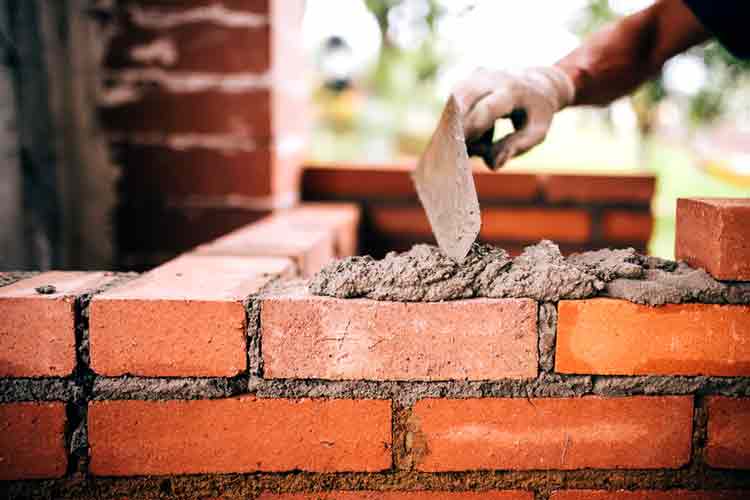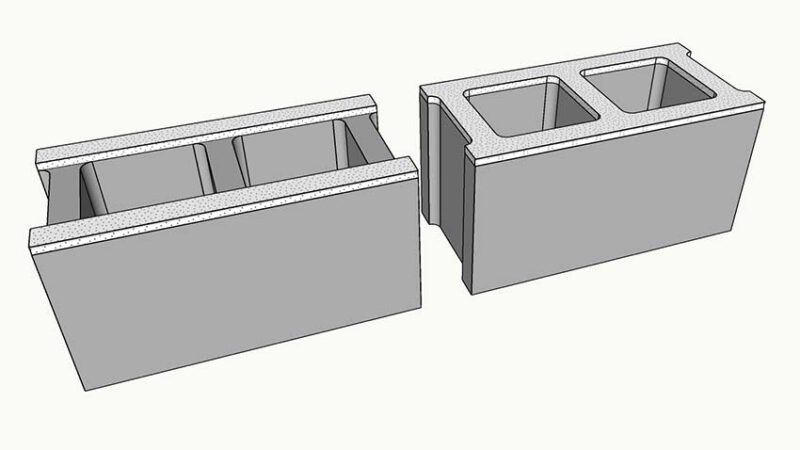Mortar is the material that sticks two masonry units together and prevents water from getting into the wall — it is what you see between bricks. Since mortar plays such an important role in masonry construction, selecting the correct type of mortar is vital.
As discussed in our article Mortar vs. Grout, mortar sticks and grout fills. We have a separate article that covers masonry grout, which is generally used to fill the cavities of concrete block.
Mortar is also used in ceramic tile construction, which we discuss at Thin-Set Tile Mortar Types.
The ingredients used in mortar are water, cement, lime, and fine aggregates like sand. The proportions of the ingredients vary based on the performance properties required in the final product (bonding strength, compressive strength, flexural strength).

Masonry Mortar Types
Mortar is classified by ASTM C 270 Standard Specification for Mortar for Unit Masonry. There are four main types of mortar, which are described below in order of decreasing strength. In addition, Type K mortar is sometimes used, but is no longer included in the ASTM C 270 standard.
Mortar is meant to be plastic, meaning it will accommodate movement within the wall without rupturing. Therefore, you should never specify a mortar that has a higher compressive strength than needed. A balance of compressive strength, flexural strength, and adhesion is required for a high quality installation.
Type M Mortar
Type M mortar is the highest strength mortar (minimum 2500 psi) and should only be used where significant compressive strength is required. This type of mortar is generally used with hard stone. Since it closely mimics the strength of stone, it will not fail before the stone itself fails.
Type M mortar is less workable than other types so it should only be specified when needed. It also lack good adhesion so it may not seal properly.
Type M Mortar Uses: Below grade applications where extreme gravity or lateral loads are present, such as in retaining walls. In conjunction with hard stone or other masonry units that have a high compressive strength.
Type S Mortar
Type S mortar is a medium-strength mortar (minimum 1800 psi). Since it is stronger than Type N, it can be used for below-grade exterior walls and other exterior projects projects like patios. In addition, it has higher bonding and lateral strength than type N, which makes it a good choice for resisting moderate soil pressures below grade.
Type S Mortar Uses: Below grade applications with normal to moderate loading. Locations where the masonry is in contact with the ground, such as paving or shallow retaining walls.
Type N Mortar (General Purpose)
Type N is the most common type of mortar and is the best all-around selection unless special characteristics are required. It is medium strength (minimum 750 psi) and is meant for reinforced interior and above-grade exterior load-bearing walls. It is great for semi-soft stone or masonry since it will flex more than a high-strength mortar — this prevents cracking of the masonry units.
Type N Mortar Uses: General purpose applications above grade where normal loading occurs.
Type O Mortar
Type O mortar is a low strength mortar (minimum 350 psi) that is used in non-load-bearing interior applications. It is easy to work with so it is often used to repair mortar where the wall is structurally sound. Type O mortar is sometimes used with masonry units that have a low compressive strength (i.e. sandstone or brownstone) so that the mortar allows more flexing, which prevents cracks in the units.
Type O Mortar Uses: Interior non-load-bearing applications with very limited exterior use. Repointing where the structural integrity of the wall is intact.
Type K Mortar
Type K mortar is no longer included in the ASTM C 270 specification; however, it is still sometimes used in historic preservation projects. It has the lowest compressive strength of any mortar so it will not cause damage to fragile stones or masonry.
Type K Mortar Uses: Historic Preservation projects where a very soft mortar is required to avoid damage to fragile stone - note that the mortar will not provide bearing capacity.
Masonry Mortar Joints
Mortar joints are typically 3/8", but can vary from 1/4" to 1/2" — we cover this more in our brick sizes article.
Bed joints are the horizontal mortar joints, or the bed of mortar that the next brick sits on. Full mortar bedding joints cover the entire top of the masonry unit and are the most common bedding type. Face shell mortar bedding has a narrow bed of mortar at the faces of the masonry unit and should only be used in interior non-load-bearing construction.


The vertical joints between masonry units are called head joints.
Joints are finished using a tool or trowel, but the tool makes for a more compact and clean finish. Each type of joint has pros and cons, which are mostly related to their effectiveness at shedding water, which is the most critical factor for weatherability.
Concave Mortar Joint
Weatherability: Good
The standard joint, which is universally accepted as the best joint for preventing water penetration.
V Mortar Joint
Weatherability: Fair
This joint is less successful at shedding water due to the point of the V, which can be an entry point for water if not tooled perfectly.
Weathered Mortar Joint
Weatherability: Good
Due to the slope of the mortar, this joint also performs fairly well. However, water can run across the underside of the brick and enter if the mortar is not well adhered.
Struck Mortar Joint
Weatherability: Very Poor
The slope of the joint pulls water into the joint and allows it to sit on the brick, which gives the water more time to penetrate.
Interior Use Only.
Flush Mortar Joint
Weatherability: Poor
This joint is susceptible to water sitting on the top of the joint if it protrudes slightly from the brick.
Raked Mortar Joint
Weatherability: Very Poor
The ledge allows water to sit on top of the brick and potentially get sucked into the wall.
Interior Use Only.
Specifying Mortar
There are two methods for specifying mortar when issuing construction documents. You can either specify the performance properties of the hardened mortar or you can specify the proportions of the ingredients in the mortar. It is absolutely critical that the specifier understand the structural requirements that the project must adhere to so that the mortar type and mix can be specified correctly. When in doubt, be sure to consult a structural engineer.
The Performance Specification, requires that a mix be created and tested in a laboratory, which makes it less common, but much more exact for critical applications. The specifier will identify the minimum compressive strength allowed after the 28-day cure period, the percentage of air in the hardened mortar, the percentage of water retained in the mortar, and aggregate ratio of the mix. Once the mix has been tested in a laboratory, the recipe can be used in the field.
For a Proportion Specification, the specifier will identify the exact proportions of ingredients for the mix. This can be done using either weights or volumes. This allows all mortar preparation to be done in the field, which makes it the most common approach since less time is involved in creating the mortar mixtures.


